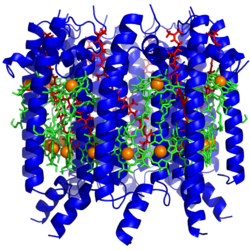Biology:Bacterial antenna complex
| Antenna complex alpha/beta subunit | |||||||||
|---|---|---|---|---|---|---|---|---|---|
 Structure of the light-harvesting complex II.[1] | |||||||||
| Identifiers | |||||||||
| Symbol | LHC | ||||||||
| Pfam | PF00556 | ||||||||
| InterPro | IPR000066 | ||||||||
| PROSITE | PDOC00748 | ||||||||
| SCOP2 | 1lgh / SCOPe / SUPFAM | ||||||||
| OPM superfamily | 2 | ||||||||
| OPM protein | 1lgh | ||||||||
| |||||||||
Bacterial antenna complex proteins are the main light-absorbing components in photosynthetic bacteria.[1] Also known as a light-harvesting complex/system, the bacterial antenna complex is responsible for the transfer of solar energy to the photosynthetic reaction centre.[2]
The Inall photosynthetic bacteria have similar features. They consist of light-absorbing pigments that are either non-covalently associated with integral proteins in the case of purple photosynthetic bacteria and cyanobacteria, or present in chlorosomes in the case of green photosynthetic bacteria.[3][4] The light-absorbing pigments in chlorosomes do not associate with integral proteins for assembly.[3] Green and purple photosynthetic bacteria utilize different bacteriochlorophyll molecules while cyanobacteria contain chlorophyll, the light-absorbing pigments found in plants.[4][3][2] Purple photosynthetic bacteria, particularly Rhodopseudomonos acidophilia of purple non-sulfur bacteria, have been one of the main groups of organisms used to study bacterial antenna complexes so much is known about this group's photosynthetic components.[5]
In Purple Photosynthetic Bacteria
In photosynthetic purple bacteria there are usually two antenna complexes that are generally composed of two types of polypeptides (alpha and beta chains).[6][7][2] These proteins are arranged in a ring-like fashion creating a cylinder that spans the membrane; the proteins bind two or three types of bacteriochlorophyll (BChl) molecules and different types of carotenoids depending on the species.[6][7] LH2 is the outer antenna complex that spans the membrane. It is peripheral to LH1, an antenna complex (also known as the core antenna complex) that is directly associated with the reaction centre.[2][5][8] Unlike for LH1 complexes, the amount of LH2 complexes present vary with growth conditions and light intensity.[2]
Both the alpha and the beta chains of antenna complexes are small proteins of 42 to 68 residues which share a three-domain organization. They are composed of a N-terminal hydrophilic cytoplasmic domain followed by a transmembrane region and a C-terminal hydrophilic periplasmic domain. In the transmembrane region of both chains there is a conserved histidine which is most probably involved in the binding of the magnesium atom of a bacteriochlorophyll group. The beta chains contain an additional conserved histidine which is located at the C-terminal extremity of the cytoplasmic domain and which is also thought to be involved in bacteriochlorophyll-binding.
The particular chemical environment of the Bchl molecules influences the wavelength of light they are able to absorb.[2][8] LH2 complexes of R. acidophils have BChl a molecules that absorb at 850 nm and 800 nm respectively.[2][8] BChl a molecules that absorb at 850 nm are present in a hydrophobic environment.[2][8] These pigments are in contact with a number of non-polar, hydrophobic residues.[8] BChl a molecules that absorb at 800 nm are present in a relatively polar environment.[2][8] The formulated N-terminus of the alpha polypeptide, a nearby histidine, and a water molecule are responsible for this.[2]
In Green Photosynthetic Bacteria
See chlorosomes.
In Cyanobacteria
See phycobilisome and Light-harvesting complexes of green plants.
Subfamilies
- Antenna complex, alpha subunit InterPro: IPR002361
- Antenna complex, beta subunit InterPro: IPR002362
References
- ↑ 1.0 1.1 "The crystal structure of the light-harvesting complex II (B800-850) from Rhodospirillum molischianum". Structure 4 (5): 581–97. May 1996. doi:10.1016/S0969-2126(96)00063-9. PMID 8736556.
- ↑ 2.0 2.1 2.2 2.3 2.4 2.5 2.6 2.7 2.8 2.9 Kühlbrandt, Werner (June 1995). "Structure and function of bacterial light-harvesting complexes". Structure 3 (6): 521–525. doi:10.1016/S0969-2126(01)00184-8. PMID 8590011.
- ↑ 3.0 3.1 3.2 Tang, Kuo-Hsiang; Blankenship, Robert E. (28 June 2011). "Neutron and light scattering studies of light-harvesting photosynthetic antenna complexes". Photosynthesis Research 111 (1–2): 205–217. doi:10.1007/s11120-011-9665-x. PMID 21710338.
- ↑ 4.0 4.1 Chen, Min; Zhang, Yinan; Blankenship, Robert E. (3 October 2007). "Nomenclature for membrane-bound light-harvesting complexes of cyanobacteria". Photosynthesis Research 95 (2–3): 147–154. doi:10.1007/s11120-007-9255-0. PMID 17912604.
- ↑ 5.0 5.1 Codgell, Richard J.; Isaacs, Neil W.; Howard, Tina D.; McLuskey, Karen; Niall, J. Fraser; Prince, Stephen M. (July 1999). "How photosynthetic bacteria harvest solar energy". Journal of Bacteriology 181 (13): 3869–3879. doi:10.1128/JB.181.13.3869-3879.1999. PMID 10383951.
- ↑ 6.0 6.1 "The primary structure of the antenna polypeptides of Ectothiorhodospira halochloris and Ectothiorhodospira halophila. Four core-type antenna polypeptides in E. halochloris and E. halophila". Eur. J. Biochem. 205 (3): 917–925. 1992. doi:10.1111/j.1432-1033.1992.tb16858.x. PMID 1577009.
- ↑ 7.0 7.1 "Structure, function and organization of antenna polypeptides and antenna complexes from the three families of Rhodospirillaneae". J. Photochem. Photobiol. B 15 (1): 113–140. 1992. doi:10.1016/1011-1344(92)87010-7. PMID 1460542.
- ↑ 8.0 8.1 8.2 8.3 8.4 8.5 McDermott, G.; Prince, S. M.; Freer, A. A.; Hawthornthwaite-Lawless, A. M.; Papiz, M. Z.; Cogdell, R. J.; Isaacs, N. W. (1995-04-06). "Crystal structure of an integral membrane light-harvesting complex from photosynthetic bacteria" (in en). Nature 374 (6522): 517–521. doi:10.1038/374517a0. ISSN 1476-4687. Bibcode: 1995Natur.374..517M.

